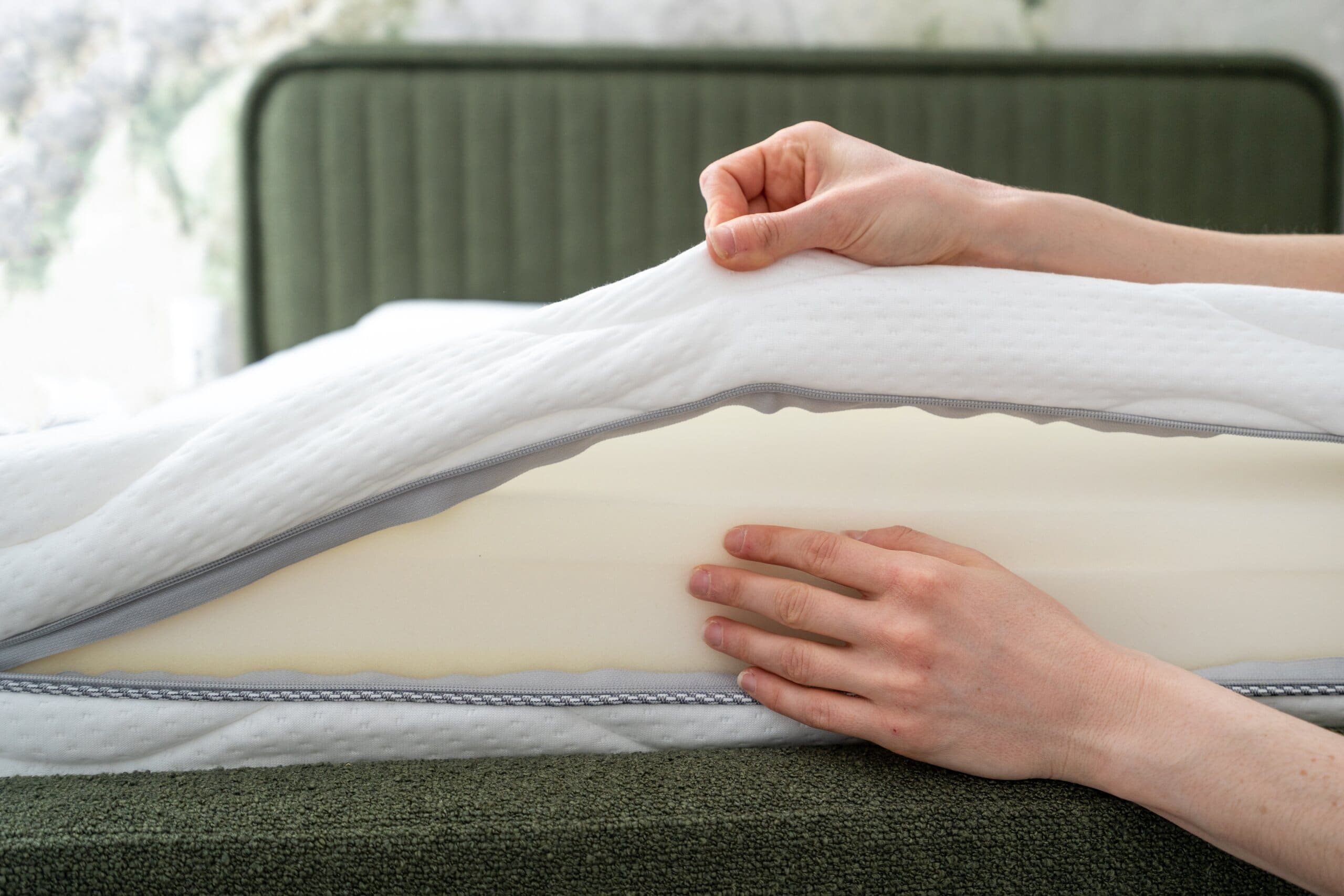Last updated: February 2025
How To Fix A Sagging Mattress
Enjoy your mattress for as long as possible by preventing mattress sagging.
By now, you’re probably tired of hearing about how a good night’s sleep is crucial for your overall well-being – but it’s true. Prioritising sleep is one of the most important things you can do if you want to stay healthy and wake up feeling refreshed each morning.
However, if you are planning on improving the duration and quality of your sleep, then it’s not enough to simply go to bed early – you also need to ensure you have a comfortable mattress underneath that supports you throughout the night.
Unfortunately, too many of us are still sleeping on old, tired, and sagging mattresses, which are quite frankly terrible for anyone looking to get a full night’s rest. Read on to learn more about why a sagging mattress is bad, and how to fix a sagging mattress as yours starts to age!

Why do mattresses sag?
There are a number of factors that contribute not only to why a mattress sags, but also how quickly it does so. That’s why it’s important to know the causes of mattress sagging so you can take steps to prevent it.
Here are the top 3 reasons mattresses sag over time:
1. Wear and tear
We spend around a third of our lives asleep, so over time our mattresses naturally experience wear and tear.
The foam and springs inside can deteriorate and lose their intended shape, and continuous pressure in the same part of a mattress will cause that area to deteriorate more quickly. If you always sleep in the same spot, repeated pressure on the same part of the mattress will likely cause an indentation. Remember that some compression is normal, but if it starts to feel uncomfortable, you're probably dealing with sagging rather than compression.
2. Low-quality materials
If a mattress isn’t constructed well or isn’t made with quality materials, it won’t be durable enough for regular use. A cheap, thin foam mattress will likely sag earlier than a quality memory foam mattress, as these materials break down more quickly.
3. Lack of support
Your bed frame plays an important role in supporting your mattress, helping it maintain its integrity and shape. If your bed frame is broken or inadequate, it can contribute to your mattress sagging.
How do you know if your mattress is sagging?
Do you have a suspicion that your mattress is starting to sag? Here’s how you can tell for sure:
1. You feel a sense of falling
If your mattress is sagging, it can’t support your weight evenly. When you try to sleep, you’ll probably feel like you’re sinking, laying at a funny angle, or like you’re falling out of or into the centre of your bed. If so, check to see if there are visible indentations on the surface that could indicate sagging.
2. You wake up tired
A sagging mattress impacts the quality of your sleep as you may struggle to get comfortable or find yourself waking up through the night to adjust your sleeping position. This prevents you from experiencing the deep, restorative, and peaceful rest we all need overnight, so you wake up feeling tired.
3. Your back aches
If your spine isn’t correctly supported due to mattress sagging, you can develop lower back pain. This is because your weight isn’t evenly distributed and you’re placing excessive pressure on certain nerves and muscles. If you wake up aching, it’s time to take a good look at your mattress.
It's important to understand the difference between mattress compression and sagging. Over time, your mattress will 'mould' to your body and gently dip in places where you exert the most pressure. This helps to keep you in a good sleeping posture and offers personalised support. However, mattress sagging is where there is a noticeable dip or sink, usually in the centre of the mattress, that makes it form a considerable indent.

Tips to prevent mattress sagging
Ok, so sagging happens… But don’t worry, these helpful tips and best practices will prolong the lifespan of your mattress, prevent premature sagging, and protect the quality of your sleep:
1. Buy the right mattress for your needs
There are many factors that determine which mattress is right for you personally, taking into consideration things like your sleeping position and physical needs.
As a rule, a mattress with good support features, like a strong core or memory foam, will help it maintain its shape and provide you with proper support while you sleep. Read our mattress buying guide to find out more about what you should be looking for.
2. Inspect your mattress regularly
Be sure to check for visible sags or bumps on the surface of your mattress at least once a month. Identifying areas that are starting to sag early will enable you to take steps to prolong the overall lifespan of your mattress before it deteriorates.
3. Rotate your mattress regularly
A great way to prevent sagging is to regularly rotate your mattress, helping to distribute weight and pressure more evenly across the surface. This reduces the likelihood of indentations in one area and prolongs the lifespan of your mattress with evenly distributed wear and tear. We suggest rotating your mattress every 3-6 months.
4. Flip your mattress
Flipping your mattress is another great way to evenly distribute the wear and tear of your mattress and prevent premature sagging in one area. How often should you flip your mattress? Check your manufacturer's guidelines first, but generally speaking we recommend doing so every 3-6 months.
5. Invest in a supportive bed frame
A supportive bed frame can significantly prolong the lifespan of your mattress and prevent premature sagging, ensuring even weight distribution and preventing shifting or bending to protect the mattress’s structural integrity.
Ensure you buy the right size for your mattress, regularly inspect the frame for damage, and avoid placing your mattress directly on the floor without support.
6. Add a mattress protector
Finally, as well as shielding your bed from sweat, dust, spills, and stains, a mattress protector will help maintain the mattress's overall quality. As an added layer of defence, it will prevent sagging that can be caused by undermining the structural integrity of your mattress via liquid damage.



How to fix a sagging mattress?
If it's too late for prevention, it’s time to try for a cure. Here are 3 ways you can try to fix mattress sagging for a better night’s sleep:
1. Try a mattress topper
An effective way of fixing mattress sagging is by using a mattress topper. The additional layer of cushioning will sit on top of your mattress for added support and comfort.
It will also help distribute your weight, reduce pressure on specific areas of sagging, and even out the indents, sags, or bumps you’re experiencing. And if your topper deteriorates, it’s easy to replace!
2. Try placing pillows strategically
If you’re experiencing a deep indentation in one particular part of the mattress, placing a pillow underneath that spot between the mattress and the bedframe will help smooth out the gap and create a more even surface.
Make sure you use pillows with good shape retention or add blankets if required. While this isn’t a permanent fix, it will provide added comfort and support in the short term to help prolong the lifespan of your mattress.
3. Replace your bed frame
We’ve already covered the importance of correct support for your mattress. But if you’re experiencing significant sagging, it could be time to replace your bed frame. A solid foundation is particularly important for memory foam mattresses, but poor support for any mattress is a prerequisite to sagging.
Check the manufacturer’s recommendation for the kind of bed frame you should buy for your mattress, and also research how to stop your mattress from sliding. (Hint: Ensure you buy a supportive bed frame!)



How long should a mattress last before sagging?
Generally speaking, a good quality mattress made from reliable materials should last seven to ten years before it starts to see significant or noticeable sagging. However, if you’ve found your brand-new mattress sagging within a few months, then you should reach out to the provider to discuss a potential replacement under your warranty.
It might be time to replace your mattress...
So, now you know why your mattress might be sagging, and how to fix mattress sagging in the future. Mattress sagging will happen eventually as a result of natural wear and tear. However, with the right care and consideration, you can ensure your mattress lasts as long as possible.
Of course, if your mattress is sagging now and you want to replace it asap, then take a look at our wide range of top-branded mattresses today. From classic double mattresses to king-sized beds, we’ve something to suit all sleepers in our selection.

